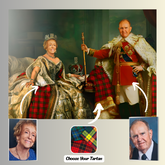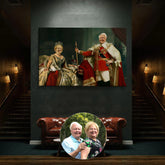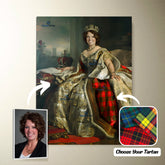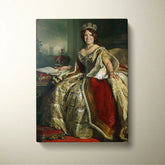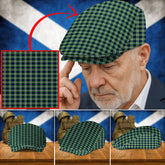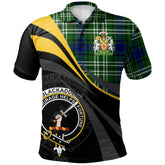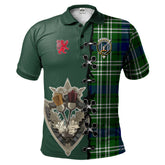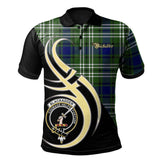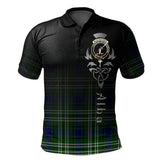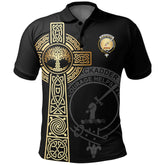-
Personalized Clan Blackadder Tartan Bagpipe Ornament with Custom Name – Scottish Christmas Tree Decoration GZ54
Personalized Clan Blackadder Tartan Bagpipe Ornament with Custom Name – Scottish Christmas Tree Decoration GZ54Celebrate your Scottish heritage with this unique wood & acrylic tartan ornament. Perfect as a personalized Christmas decoration or a meaningful gift for friends and relatives on special occasions such...- From $19.99 USD
$25.99 USD- From $19.99 USD
- Unit price
- per
Save $6.00 -
Personalized Clan Blackadder Tartan Drummer Ornament with Custom Name – Scottish Christmas Tree Decoration YT71
Personalized Clan Blackadder Tartan Drummer Ornament with Custom Name – Scottish Christmas Tree Decoration YT71Celebrate your Scottish heritage with this unique wood & acrylic tartan ornament. Perfect as a personalized Christmas decoration or a meaningful gift for friends and relatives on special occasions such...- From $19.99 USD
$25.99 USD- From $19.99 USD
- Unit price
- per
Save $6.00 -
Personalized Clan Blackadder Tartan Bagpipe Ornament with Custom Name – Scottish Christmas Tree Decoration YI16
Personalized Clan Blackadder Tartan Bagpipe Ornament with Custom Name – Scottish Christmas Tree Decoration YI16Celebrate your Scottish heritage with this unique wood & acrylic tartan ornament. Perfect as a personalized Christmas decoration or a meaningful gift for friends and relatives on special occasions such...- From $19.99 USD
$25.99 USD- From $19.99 USD
- Unit price
- per
Save $6.00 -
Custom Name Clan Blackadder Tartan Garden Flag with Clan Crest and the Golden Sword of Courageous Legacy KX56 - Blackadder
Custom Name Clan Blackadder Tartan Garden Flag with Clan Crest and the Golden Sword of Courageous Legacy KX56 Immerse your space in the rich heritage of Scotland with our Tartan Garden Flags, exclusively from Tartan Today. Featuring vibrant tartan and Scottish heritage designs, these garden...- From $34.45 USD
- From $34.45 USD
- Unit price
- per
-
Blackadder
-
Clan Blackadder Tartan Scotland Map Canvas “Tartan Runs Through My Veins” Wall Art DA16
Clan Blackadder Tartan Scotland Map Canvas “Tartan Runs Through My Veins” Wall Art DA16Celebrate your Scottish heritage with this striking canvas print featuring the map of Scotland filled with Blackadder tartan, paired with the bold phrase: “Tartan Runs Through My Veins.” Whether you're honoring...- From $35.05 USD
- From $35.05 USD
- Unit price
- per
-
Personalized Clan Blackadder Tartan Shirt with Scotland Coat of Arms & Custom Name PQ42 - Blackadder
Blackadder Tartan Shirt with Scotland Coat of Arms & Custom Name PQ42Celebrate your Scottish heritage with this Blackadder Tartan Shirt with Scotland Coat of Arms & Custom Name PQ42, featuring a bold Scotland Coat of Arms and your custom name on the back. Made...- From $39.54 USD
- From $39.54 USD
- Unit price
- per
-
Blackadder
-
Clan Blackadder Tartan Custom Face Hawaiian Shirt – Unisex Gift for Family Members, Summer Party WV94 - Blackadder Tartan
Clan Blackadder Tartan Custom Face Hawaiian Shirt – Unisex Gift for Family Members, Summer Party WV94?? Stand out with our custom face Hawaiian shirt featuring your chosen tartan pattern and up to 10 faces printed for free! Whether it's your own, your pet's, or...- $42.25 USD
$59.99 USD- $42.25 USD
- Unit price
- per
Save $17.74-
Blackadder Tartan
-
Clan Blackadder Tartan Flat Cap MJ91 - Clan Blackadder Tartan
Clan Blackadder Tartan Flat Cap MJ91Elevate Your Heritage: The Authentic Tartan Jeff Cap Step into a legacy of timeless style and comfort with our Authentic Tartan Flat Cap. Crafted for the discerning American who cherishes their Scottish roots and appreciates classic elegance, this isn’t just...- From $33.85 USD
$45.59 USD- From $33.85 USD
- Unit price
- per
Save $11.74-
Clan Blackadder Tartan
-
Clan Blackadder Tartan Crest, Badges, Heraldry, Clans, Family Scotland PNG, Digital ClipArt High Quality HT15
Clan Blackadder Tartan Crest, Badges, Heraldry, Clans, Family Scotland PNG, Digital ClipArt High Quality HT15 DIGITAL FILE ONLY* ** This listing is an INSTANT DIGITAL DOWNLOAD, not a physical item. An instant download is a digital file you can download and use immediately **...- $3.49 USD
$5.99 USD- $3.49 USD
- Unit price
- per
Save $2.50 -
Clan Blackadder Tartan Polo Shirt Viking Wolf SX11 - Blackadder Tartan
Clan Blackadder Tartan Polo Shirt Viking Wolf SX11 Description: Crafted in 100% polyester with your own design which combines comfort and vogue. This shirt has some'great features, it has 3 buttons, elastic collar and cuffs. 12.35 Oz. Made from polyester fabric. 3 buttons, elastic...- $38.25 USD
- $38.25 USD
- Unit price
- per
-
Blackadder Tartan
-
Clan Blackadder Tartan Polo Shirt Half of Me - Cross Style TJ74 - Blackadder Tartan
Clan Blackadder Tartan Polo Shirt Half of Me - Cross Style TJ74 Description: Crafted in 100% polyester with your own design which combines comfort and vogue. This shirt has some'great features, it has 3 buttons, elastic collar and cuffs. 12.35 Oz. Made from polyester...- $38.25 USD
- $38.25 USD
- Unit price
- per
-
Blackadder Tartan
-
Clan Blackadder Tartan Polo Shirt - Royal Coat Of Arms Style KZ90 - Blackadder Tartan
Clan Blackadder Tartan Polo Shirt - Royal Coat Of Arms Style KZ90 Description: Crafted in 100% polyester with your own design which combines comfort and vogue. This shirt has some'great features, it has 3 buttons, elastic collar and cuffs. 12.35 Oz. Made from polyester...- $38.25 USD
- $38.25 USD
- Unit price
- per
-
Blackadder Tartan
-
Clan Blackadder Tartan Polo Shirt - Lion Rampant And Celtic Thistle Style ZF35 - Blackadder Tartan
Clan Blackadder Tartan Polo Shirt - Lion Rampant And Celtic Thistle Style ZF35 Description: Crafted in 100% polyester with your own design which combines comfort and vogue. This shirt has some'great features, it has 3 buttons, elastic collar and cuffs. 12.35 Oz. Made from...- $38.25 USD
- $38.25 USD
- Unit price
- per
-
Blackadder Tartan
-
Clan Blackadder Tartan Polo Shirt - Believe In Me Style ZN83 - Blackadder Tartan
Clan Blackadder Tartan Polo Shirt - Believe In Me Style ZN83 Description: Crafted in 100% polyester with your own design which combines comfort and vogue. This shirt has some'great features, it has 3 buttons, elastic collar and cuffs. 12.35 Oz. Made from polyester fabric....- $38.25 USD
- $38.25 USD
- Unit price
- per
-
Blackadder Tartan
-
Clan Blackadder Tartan Polo Shirt - Alba Celtic Style OB48 - Blackadder Tartan
Clan Blackadder Tartan Polo Shirt - Alba Celtic Style OB48 Description: Crafted in 100% polyester with your own design which combines comfort and vogue. This shirt has some'great features, it has 3 buttons, elastic collar and cuffs. 12.35 Oz. Made from polyester fabric. 3...- $38.25 USD
- $38.25 USD
- Unit price
- per
-
Blackadder Tartan
-
Clan Blackadder Tartan Polo Shirt CQ73 - Blackadder Tartan
Clan Blackadder Tartan Polo Shirt CQ73 Description: Crafted in 100% polyester with your own design which combines comfort and vogue. This shirt has some'great features, it has 3 buttons, elastic collar and cuffs. 12.35 Oz. Made from polyester fabric. 3 buttons, elastic collar and...- $38.25 USD
- $38.25 USD
- Unit price
- per
-
Blackadder Tartan
-
Clan Blackadder Clan Unisex Polo Shirt - Celtic Tree Of Life QO90 - Blackadder Tartan
Clan Blackadder Clan Unisex Polo Shirt - Celtic Tree Of Life QO90 Description: Crafted in 100% polyester with your own design which combines comfort and vogue. This shirt has some'great features, it has 3 buttons, elastic collar and cuffs. 12.35 Oz. Made from polyester...- $38.25 USD
- $38.25 USD
- Unit price
- per
-
Blackadder Tartan
-
Clan Blackadder Clan Polo Shirt Viking Wolf KI39 - Blackadder
Clan Blackadder Clan Polo Shirt Viking Wolf KI39 Description: Crafted in 100% polyester with your own design which combines comfort and vogue. This shirt has some'great features, it has 3 buttons, elastic collar and cuffs. 12.35 Oz. Made from polyester fabric. 3 buttons, elastic...- $38.25 USD
- $38.25 USD
- Unit price
- per
-
Blackadder
-
Clan Blackadder Clan - Military Polo Shirt LJ96 - Blackadder Tartan
Clan Blackadder Clan - Military Polo Shirt LJ96 Description: Crafted in 100% polyester with your own design which combines comfort and vogue. This shirt has some'great features, it has 3 buttons, elastic collar and cuffs. 12.35 Oz. Made from polyester fabric. 3 buttons, elastic...- $38.25 USD
- $38.25 USD
- Unit price
- per
-
Blackadder Tartan
-
Blackadder Tartan Clan Crest Badge Aloha Hawaiian Shirt Tropical Old Style KO26 - Blackadder Tartan
Blackadder Tartan Clan Crest Badge Aloha Hawaiian Shirt Tropical Old Style KO26 These Hawaiian shirts and shorts are suitable for hot summer days or beach trips with your friends, family, and loved ones. This is an excellent gift, vacation outfit, or simply revamp your...- $43.25 USD
- $43.25 USD
- Unit price
- per
-
Blackadder Tartan
Ex: Your Tartan + Product
Popular Products
Turn Me Royal Personalized Portrait from Your Photo, Custom Tartan. Custom Canvas Wall Art as Gift for Men
- From $32.45 USD
- From $32.45 USD
- Unit price
- / per
Royalty Couple Personalized Portrait from Your Photo, Custom Tartan. Custom Canvas Wall Art
- From $47.45 USD
- From $47.45 USD
- Unit price
- / per
The Queen Personalized Portrait from Your Photo, Custom Tartan. Custom Canvas Wall Art as Gift for Women
- From $32.45 USD
- From $32.45 USD
- Unit price
- / per
Which Clan Are You From?
List Of Tartan
-
Clan A
- Abercrombie Tartan
- Aberdeen Tartan
- Abernethy Tartan
- Adair Tartan
- Adam Tartan
- Ayrshire Tartan
- Agnew Tartan
- Aikenhead Tartan
- Ainslie Tartan
- Aiton Tartan
- Allan Tartan
- Alexander Tartan
- Allardice Tartan
- Allison Tartan
- Anderson Tartan
- Angus Tartan
- Anstruther Tartan
- Arbuthnot Tartan
- Armstrong Tartan
- Arnott Tartan
- Auchinleck Tartan
- Ayrshire Tartan
-
Clan B
- Baillie Tartan
- Bain Tartan
- Baird Tartan
- Balfour Tartan
- Bannatyne Tartan
- Bannerman Tartan
- Barclay Tartan
- Baxter Tartan
- Beaton Tartan
- Bell Tartan
- Belshes Tartan
- Bethune Tartan
- Beveridge Tartan
- Binning Tartan
- Bisset Tartan
- Blackadder Tartan
- Blackstock Tartan
- Black Watch Tartan
- Blair Tartan
- Blane Tartan
- Blyth Tartan
- Borthwick Tartan
- Boswell Tartan
- Bowie Tartan
- Boyd Tartan
- Boyle Tartan
- Brisbane Tartan
- Brodie Tartan
- Brown/ Broun Tartan
- Bruce Tartan
- Buccleuch Tartan
- Buchan Tartan
- Buchanan Tartan
- Burnett Tartan
- Burns Tartan
- Butter Tartan
- Byres Tartan
-
Clan C
- Cairns Tartan
- Calder Tartan
- Callander Tartan
- Cameron Tartan
- Campbell Tartan
- Campbell of Breadalbane Tartan
- Campbell of Cawdor Tartan
- Carmichael Tartan
- Carnegie Tartan
- Carruthers Tartan
- Cathcart Tartan
- Chalmers Tartan
- Charteris Tartan
- Chattan Tartan
- Cheyne Tartan
- Chisholm Tartan
- Christie Tartan
- Clark Tartan
- Clelland Tartan
- Clephan Tartan
- Clergy Tartan
- Cochrane Tartan
- Cockburn Tartan
- Colquhoun Tartan
- Colville Tartan
- Cooper Tartan
- Couper Tartan
- Craig Tartan
- Cranstoun Tartan
- Crawford Tartan
- Crichton Tartan
- Crief District Tartan
- Crosbie Tartan
- Cumming Tartan
- Cunningham Tartan
- Currie Tartan
- Clan D
- Clan E
- Clan F
- Clan G
- Clan H
- Clan I
- Clan J
- Clan K
- Clan L
-
Clan M
- Maitland Tartan
- Malcolm Tartan
- Mar Tartan
- Marjoribanks Tartan
- Maxtone Tartan
- Matheson Tartan
- Maule Tartan
- Maxwell Tartan
- Meldrum Tartan
- Melville Tartan
- Menzies Tartan
- Mercer Tartan
- Middleton Tartan
- Moffat Tartan
- Moncrieffe Tartan
- Montgomery Tartan
- Monypenny Tartan
- Moncreiffe Tartan
- Monteith Tartan
- Morrison Tartan
- Mouat Tartan
- Moubray Tartan
- Mow Tartan
- Muir_More Tartan
- Muirhead Tartan
- Munro Tartan
- Murray Tartan
- Murray of Atholl Tartan
-
Clan Mc/Mac
- MacAlister Tartan
- MacArthur Tartan
- MacAlpine Tartan
- MacAulay Tartan
- MacBain Tartan
- MacBean Tartan
- MacBeth Tartan
- MacCallum Tartan
- MacCraig Tartan
- MacColl Tartan
- MacCorquodale Tartan
- MacDiarmid Tartan
- MacDonald Tartan
- MacDonald of Clanranald Tartan
- MacDonald of Sleat Tartan
- MacDonnell of Glengarry Tartan
- MacDonnell of Keppoch Tartan
- MacDougall Tartan
- MacDowall Tartan
- MacDuff Tartan
- MacEwen_MacEwan Tartan
- MacEdward Tartan
- MacFarlane Tartan
- MacGill Tartan
- MacGillivray Tartan
- MacGregor Tartan
- MacGowan (McGowan) Tartan
- MacHardy Tartan
- MacIan Tartan
- MacInnes Tartan
- MacIntyre Tartan
- MacKay Tartan
- MacKillop Tartan
- MacKellar Tartan
- Mackinlay Tartan
- MacKenzie Tartan
- Mackie Tartan
- MacKinnon Tartan
- MacKintosh / MacIntosh Tartan
- MacLeod Tartan
- MacMillan Tartan
- MacNab Tartan
- MacNaughton Tartan
- MacNeil / MacNeill Tartan
- MacNeil of Colonsay Tartan
- MacNicol Tartan
- MacPhail Tartan
- MacPhee_MacFie Tartan
- MacPherson Tartan
- MacQuarrie Tartan
- MacQueen Tartan
- MacRae Tartan
- MacRow Tartan
- MacSporran Tartan
- MacTaggart Tartan
- MacTavish Tartan
- MacThomas Tartan
- McCorquodale Tartan
- McCulloch Tartan
- McFadzen Tartan
- McGeachie Tartan
- McIver Tartan
- McKerrell Tartan
- Clan N
- Clan O
- Clan P
- Clan R
-
Clan S
- Sandilands Tartan
- Scott Tartan
- Scrymgeour Tartan
- Selkirk Tartan
- Sempill Tartan
- Seton Tartan
- Shaw Tartan
- Shepherd Tartan
- Sinclair Tartan
- Skene Tartan
- Skirving Tartan
- Smith Tartan
- Somerville Tartan
- Spalding Tartan
- Spens Tartan
- Spottiswood Tartan
- Stevenson Tartan
- Stewart Tartan
- Stewart of Appin Tartan
- Stirling Tartan
- Strachan Tartan
- Straiton Tartan
- Strange Tartan
- Strathclyde District Tartan
- Stuart of Bute Tartan
- Sutherland Tartan
- Swinton Tartan
- Clan T
- Clan U W Y
- Request Your Clan
Clan Blackadder (Blackadder Tartan)
1. About Clan Blackadder (Blackadder Tartan)
2. Clan Blackadder History (Blackadder Tartan)
The Blackadder River and Estates in Berwickshire are the inspiration for the clan's name. In 1477, Adam of Blackathir was among those despatched as a guide for the envoys carrying Princess Cecilia's dower to Edinburgh.
In 1486, Charles Blackater was given security and was guided safely across England.
Glasgow's bishop at the end of the 15th century was Robert Blackadder. Roland Blacadyr, who appears as the sub-dean of Glasgow in 1524, may be the same Roland Blaykatter who was a tenant in the barony of Glasgow in 1521.
In 1557, Thomas Blacater served as the Commendator of Coldingham's bailie.
The Blacaters of Tulliallan in Perthshire (from which they were expelled in 1632) were a branch of the Border line, and the name was popular in Lanarkshire in the 16th century.
Distinguished Church of Scotland minister John Blackadder of Tulliallan. As a Covanenter, he was imprisoned on Bass Rock, where he passed away in 1685.
3. Clan Blackadder Tartans
Although the Tweedside District tartan, which represents the region where the name is from, is permitted, there is no officially recognized Blackadder tartan.
Tweedside District
4. Clan Blackadder Crest & Coats of Arms
4.1 Clan Blackadder Crest
Worn by all of the name and ancestry
4.2 Clan Blackadder Coat of Arms
Note on Coats of Arms: A coat of arms is given to an individual under Scottish heraldic law (with the exception of civic or corporate arms). A 'family coat of arms' does not exist.
With the exclusions listed above, the weapons depicted below are personal weapons. The only person authorized to use these weapons is the grantee.
5 .Clan Blackadder Places & People
5.1 Clan Blackadder Places
During James II's (1437–1460) reign, the Blackadder family—a notable clan in the Borders region—greatly increased the size of their possessions.
The majority of the Borders properties owned by the Blackadders of that ilk were, however, destroyed when, in 1518, Robert Blackadder's two daughters—his only heirs—were compelled to wed members of the nearby Home of Wedderburn family.
On the Blackadder estates, close to Allanton in Berwickshire, there formerly stood a stronghold that English troops decimated in the early 16th century.
Stately Blackadder House was constructed on the same property and underwent numerous additions in the nineteenth century. Soldiers who lived in Blackadder House during the First World War severely vandalized it.
The home rapidly deteriorated as a result of the post-war administration's refusal to pay for repairs, and it was eventually demolished in 1925.
5.2 Clan Blackadder People
5.2.1 John Blackadder (1622–1685)
Sometime about 1622 saw the birth of Blackadder. As the first baronet, he succeeded his grandfather Adam Blackadder of Blairhall, who was the Blackadder Baronetcy of Tulliallan's cadet. a title he was unwilling to accept.
At Glasgow University, he majored in divinity. Seven kids were born to him and Janet Haining.
Near Dumfries, Troqueer, on June 7, 1653, Blackadder received his ordination as a preacher. Blackadder, a Covenanter, was exiled from court following the restoration of Charles II. He was momentarily detained, brought to Edinburgh, and afterwards freed.
He was expelled from Glencairn by the authorities, but he persisted in preaching at covert gatherings there. Then Blackadder began living as a traveling preacher, mostly in the southern part of Scotland.
As more members of the audience started to bring weapons to defend themselves against an attack by government forces, these outdoor sermons became more militarized.
Blackadder was made an outlaw with a prize for his apprehension as a result of the hostility between the two groups. Blackadder made the decision to relocate to Rotterdam following the Battle of Bothwell Bridge.
His arrest in Edinburgh, conviction, and imprisonment on the infamous Bass Rock followed his return in 1681. His imprisonment's conditions were so appalling that he fell ill and passed away in 1685. In the churchyard of North Berwick, he is interred.
5.2.2 Dame Elizabeth Violet Blackadder (24 September 1931 - 23 August 2021)
Printed-media artist and Scottish painter Elizabeth Blackadder. For both the Royal Scottish Academy and the Royal Academy, she was the first woman to be elected.
Blackadder was born and raised in Falkirk, and when she was ten years old, her father passed away. She was a loner as a child and spent a lot of time reading and gathering flowers.
She was accepted to College in Edinburgh in 1949 to pursue a degree in fine art, and in 1954 she received her First Class Honors diploma. While there, she met John Houston, an artist who would become her husband.
She studied Byzantine art while taking long trips across Yugoslavia, Greece, and Italy after receiving her degree.
As she traveled more, Blackadder developed a keen interest in still life painting, for which she is best known. She received the OBE in 1982 and was elevated to the rank of DBE (dame) in 2003.
She also has four honorary doctorates and served as Her Majesty's Painter and Limner on Scotland from 2001 to 2002.
Her creations have been preserved on stamps and even the official Christmas card for Scotland's First Minister in 2012.
In 2021, Elizabeth Blackadder passed away on August 23rd, one month before turning 90.
- Choosing a selection results in a full page refresh.



